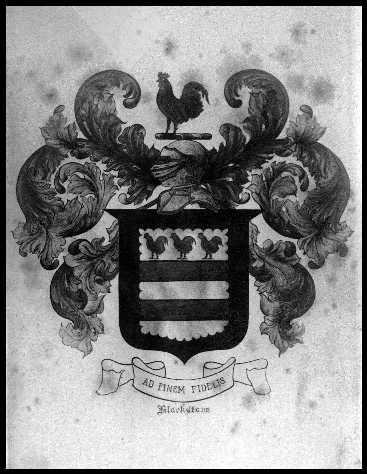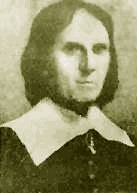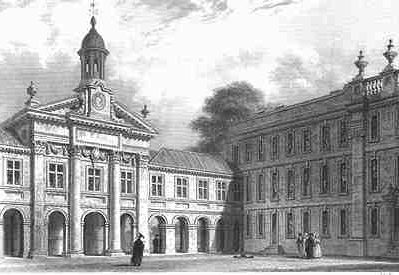|
William Blackstone - (Reverend)
- Born: March 5, 1595, Horncastle, Lincoln, England
- Married: July 4, 1659, Massachusetts, U.S.A
- Died: May 26, 1675, Pawtucket River, Rehoboth, Massachusetts, U.S.A.


Marriage Information:
William married Sarah Fisher, daughter of Thomas Fisher, on July 4, 1659 in
Massachusetts, U.S.A. Sarah Fisher was born in 1625 in Durham, England and died in June 1673
in Rehoboth, Massachusetts, U.S.A.


General Notes:
The following was written for a English Research Paper by my daughter (Name withheld for privacy).
Reverend William Blackstone
November 26, 2001

|
Outline
Thesis Statement:
Reverend Blackstone, my ninth great grandfather, was one of the original settlers who helped establish the community now known as Boston and Rhode Island.
I. Introduction
II. Reverend William Blackstone's early life in England:
a) The origin of the name Blackstone
b) William's life before coming over to America
c) William's family
III. Reverend Blackstone's departure from England and arrival in America:
a) His arrival in Boston
b) Life and home in Boston
c) Departure from Boston
IV. Reverend William Blackstone's life in Rhode Island:
a) His home and life in Rhode Island
b) William's marriage and the birth of his only son
c) The death of William and his wife
V. Conclusion
Appendices
The Blackstone Coat of Arms
Reverend William Blackstone
Emmanuel College

Reverend William Blackstone
Reverend William Blackstone, my ninth great-grandfather, was one of the original settlers who helped establish the communities now known as Boston and Rhode Island. William had many accomplishments in his life. William was born and raised in Durham England and later journeyed to America in 1623. Rev. William Blackstone established himself as a homesteader on a piece of land that the First Nations called Shawmut. Shawmut later became known as Boston, Massachusetts. Later, he moved to Rehoboth, now known as Cumberland, Rhode Island, where he eventually married and had a son. Here he lived the remainder of his life.
I am related to William Blackstone through my mother's side of the family. The descendants to myself from Rev. William Blackstone start with John Blackstone, his only son. John had a son named John Jr.; John Jr. had a son named John III. John III's fourth son was named Stephen Foote Blackstone, who is my fourth great-grandfather. Stephen was elected Judge of Madison County Court in the year 1810. Stephen Foote's first son was named Stephen. Stephen came to Canada to start a new life at about the age of 18. All of his family were born in Canada. Stephen's second son, Edward, had a son named Elbert Leroy my second great-grandfather. Elbert's son was James Leroy, my great-grandfather. James's son was David, my grandfather. That is how my line of the Blackstone came to be known here in Canada.
The origins of the Blackstone name originate about the time of William the Conqueror in the year 1066. Everyone at that time was called by his first name. However, William I declared that they should have surnames. The name Blackstone is believed to have come from the range of hills on the border of England and Scotland, which was called Blackstone hills (Blackstone, N.B, "The Adventure..."no page number). There are many different spellings of Blackstone, but the most common ones are Blakiston, Blaxton and Blackstone. (Blackstone, N.B., "The Biography of..." no page number) The Blackstones have a Coat of Arms, which is described as
|
Ar two bars gu. in chief three cock of the second. When translated the arms description is silver, two horizontal red bands, in top three red cocks. Above the shield and helmet is the crest which is described as A cock or. A translation of the crest description is a gold cock. (qtd in Blackstone N.B page 10 "The Biography of...")(See Appendix A) |
That is how the Blackstone name came to be known throughout the world.
When William was born, he was destined to be a man of many firsts.
William Blackstone was born March 5, 1595, at Gibside, Whickham, Durham County, England
(Blackstone N.B., "The Biography of..." no page number).
He was baptized at Horncastle Parish, Lincolnshire. William parents were John and Agnes
(Hawley) Blackstone.
|
"William became a man of great talent, and although
eccentric in many respects, managed to maintain the character of an exemplary Christian"
(qtd in Blackstone N.B. "The Biography of..." , no page number)(See Appendix B).
|
William had four brothers and three sisters. William's four brothers were Ralph the oldest, then Nathaniel, John and the last was George. William's sisters were named Frances, the oldest, then Ann and then Muriel. On December 8, 1602, William's mother died. William was only seven years old at the time. Then on July 2, 1607, his sister Muriel died at the age of 5 years and 8 months. At the age of 12, William finished elementary school, and in September 1609 he entered Emmanuel, College, Cambridge, England. At the age of 26 William earned the degrees of M.A., and in the some year he took the Oath in the Church of England, then graduated from Emmanuel College, Cambridge (Blackstone N.B. "The Biography of...") (See Appendix C). William Blackstone had a kind heart capable of feeling for the suffering of his fellow men (Drake 4). Three days before his 27th birthday his father died, and his oldest brother Ralph inherited the estate (Blackstone N.B., "The Biography of...", no page number).
In June, Captain Robert Gorges agreed to take with him to the Americas two ordained clergymen: Reverend William Morell, superintendent over the churches of New England at Plymouth, and the other clergyman was the ordained companion of William Morell, the Reverend William Blackstone. Blackstone was originally designed to take charge, under the power of superintendency of the Plymouth pulpit, while Morell was to minister at the Bay. (Blackstone N.B., "The Biography of...", no page number). A possible reason why William left his homeland to come to America was that William and the Lord Bishops had different opinions on how the church should function
(Blackstone N.B., "The Biography of..." no page number).
Captain Gorges left England in early August 1623. They reached New England
in middle of September (Blackstone N.B. "The Biography of...", no page number). William came
to this country shortly after the Pilgrim Fathers.
|
He come to this country from England soon
after the Pilgrim Fathers as early as 1625-1626, Though some place the date at 1623, and
settled first in Boston called by the Indians "Shawmut" meaning a spring of water. Here he
commenced his solitary life, built his home cultivated his land and planted the orchards
where the first apples in Massachusetts were grown. He had undoubtedly occupied the peninsula
several years and alone before the arrival of Governor Winthroip and company in 1630
(qtd Blackstone J.W, 35)
|
At the age of 28, William arrived in the New World. Two years later
he moved to the North Shore establishing himself on the Western slopes of the Peninsula of
Shawmut, on the other side of Charles River. (Blackstone N.B "The Biography of..."
no page number)
|
" His name has become celebrated wherever the early history of the New England is known"
(qtd in Blackstone, J.W. 34).
|
When William came over from England, he brought about 186 books in various languages (Blackstone N.B., "The Biography of...", no page number). Then in 1625, Captain Gorges and Reverend William Morell returned to England.
In 1630, Governor Winthrop sailed into what is now Boston Bay, and found that William built himself a home, planted an orchard and was living quite comfortably (Blackstone N.B., "The Biography of...", no page number). In July 1630, was when William invited Governor Winthrop and his group to his side of the river, as there water was bad and people were dying.
|
Governor Winthrop sailed into Boston Harbor in July 1630 in his flagship Arabella of 350 tons
and 28 guns along with the Talbot and the Jewel. They landed at Charlestown where sickness
soon befell them due to the lack of good drinking water, which, in turn, exacted a heavy toll
in lives. Reverend William on the other side of the Charles River, being a witness to this
terrible scene and a man who often "thanked God" for his many blessings, promptly offered to
share with those less fortunate, possible knowing full well the eventual consequences.
Never-the-less, Reverend William could not turn his back on these unfortunate people.
Needless to say Governor Winthrop and several hundred of his followers came to Shawmut,
taking full advantage of Reverend William's offer of assistance. For the next four years,
the 35 year old William was anything but a hermit!
(qtd in Blackstone N.B., "The Blackstone
Family...", no page number)
|
On May 18, 1631, Reverend William Blackstone, age 36, took the
freemen's oath; he was the first to do so.
|
"To become a Freeman, a person was legally required to be a respectable member of some
congregational church. In early colonial America, requirements to vote and hold public office
included owning land and being declared "free" from bandage." (qtd in Emmons paragraph one)
|
On April 1, 1633 Governor Winthrop, granted William 50 acres of some
800 acres of land that he had claimed for more than eight years.
(Blackstone, N.B., "The Biography of...", no page number). In June of that year, William
sold his land and left Boston because he did not like the people's beliefs and how they were
running Shawmut. Lead by his bull, William he took his worldly possessions and driving his
herd, picked up the Aboriginal trail that brought him to a spot on the Pawtucket River, which
is now called the Blackstone River. Leaving behind a good home, William became the first
settler in Rehoboth. (Blackstone N.B., "The Biography of...", no page number).
|
Thus, William Blackstone attained another first. He was the first settler of Boston area;
he had the first library, of any consequence in New England; he owned the first bull; and the
first to take the "Freeman's Oath." And now he is repeating those "firsts" in Rhode Island;
the first settler, library, bull and the apple orchard. A man of many first as one can
readily see, but it is unlikely that he was cognizant of the facts at that time.
(qtd in Blackstone N.B., "The Biography of...", no page number)
|
On the banks of the Pawtucket River, William built himself a home in a place called The Gore about three miles above the Village of Pawtucket. His house was surrounded by a garden, an orchard and by a native park, in which William took his daily walks and tended his flocks. While he was out there, he read the great books that were the inspiration of Roman and Grecian Cultures (Blackstone, J.W, 44).
In January 1636, Roger Williams found William living on a piece of land, which became known as Study Hill. William also named his house Study Hall (Blackstone N.B, "The Biography of...", no page number). On the east side of the hill he put his orchard (Blackstone J.W., 44).
When William was 64, Sarah Stevenson approached William on one of his trips into Boston. Sarah had a very serious problem. Her husband had just died and they were not well off. William came up with a solution to her problem. William asked Sarah to marry him. On July 4, 1659, they were married in Boston by Governor John Endicott. Sarah came into this marriage with six children. The oldest was Onesimus. He worked on a ship and was never heard from again. Her second son was John who stayed with his mother. The third son was Paul. Her fourth son was Joseph and he died six months later. The fifth son was James. He showed up after his brother John death. Sarah had one daughter named Sarah (Blackstone N.B., "The Biography of..." no page number).
At the age of 35, Sarah gave William his first son John. At the time William was 65 years old. John was raised by his mother until her death in 1673. When John's mother died he was only 13 years old, and when his father died John was 15 years old. Sarah Blackstone was buried on June 15, 1673, at the age of 48. William Blackstone died on May 26, 1675 at the age of 81; he was buried on May 28, 1675, beside his wife Sarah on the side of Study Hill. At the head and foot of the graves, there were stones of partly crystallized quartz. They remained there until 211 years later, when they were moved to the Lansdale site. William and Sarah's grave was moved for the sake of progress. The town was going to build a mill on the old property (Blackstone N.B., " The Blackstone Family..." no page number). A brief note in the old records about William by his good friend Roger Williams states
|
About a fortnight since your old acquaintance Mr. Blackstone departed this life in the four
score year of his age. Four days before his death, he had a great pain in his breast and back
and bowers. Afterwards he said he was well had nor pain and should live; but he grew fainter
and yielded up his breath without a groan. (qtd in Blackstone N.B., "The Blackstone
Family..." no page number)
|
John was appointed a guardian by the courts after his father and mother death. The courts allotted 50 acres of land and five acres of meadow to John Stevenson and the balance of the estate to John Blackstone. In 1690, John Blackstone married Katherine Gorham. After his father's death John Blackstone's inheritance was wasted by the King Philip Indian War. Shortly after William's death Natives buried the house and personal belonging leaving only the land for John Blackstone's inheritance (Blackstone N.B., "The life of John..." no page number).
With this research, I leaned a lot about my ninth great grandfather. William achieved a lot in his lifetime, like being first settler of Boston and Rhode Island, the first to have a bull in America, the first to have a library in America and one of the first to take the freeman's oath. William seems to have been a quiet person by nature, but seemed to have a hard life. I am glad to be part of the Blackstone family tree.

Work Cited
Blackstone, John Wilford. Lineage and History of William Blackstone, First settler of Boston, and his Descendants form his Birth - 1595, to the close of the revolution -1782.
(No publisher), 1907.
Blackstone, Nathaniel Brewster. " The Adventure (The family Coat of Arms)." Homestead, Florida: N.E. Historic Genealogical Society, 1974.
Blackstone, Nathaniel Brewster. " The Blackstone Family being Sketches Biographical and Genealogical Reverend William Blackstone the Pioneer of Boston and His Ancestor and Descendents." Homestead, Florida: N.E. Historic Genealogical Society, 1974.
Blackstone, Nathaniel Brewster. " The life of John Blackstone 1660-1743 only son of Reverend William Blackstone." Homestead, Florida: N.E. Historic Genealogical Society, 1974.
Drake, Samuel Adams. " Historic Personages of Boston." Boston: James R Osgood and Company, 1873.
Emmons, Edward Neville. "Freeman Oath." "The Emmons Family Genealogy." 2000. Online ancestry.com. , (no publisher) Available: "http://freepages.genealogy.rootweb.com/~dotspage/freeman's_oath.htm" November 5, 2001.

|
Appendix A

The Blackstone Coat of Arms

Appendix B

Reverend William Blackstone

Appendix C
Emmanuel College

The front of Emmanuel College, in Cambridge England

The Courtyard of Emmanuel College, in Cambridge England


Events:
1. Possible: Blackstone was spelt "Blaxton".
|



